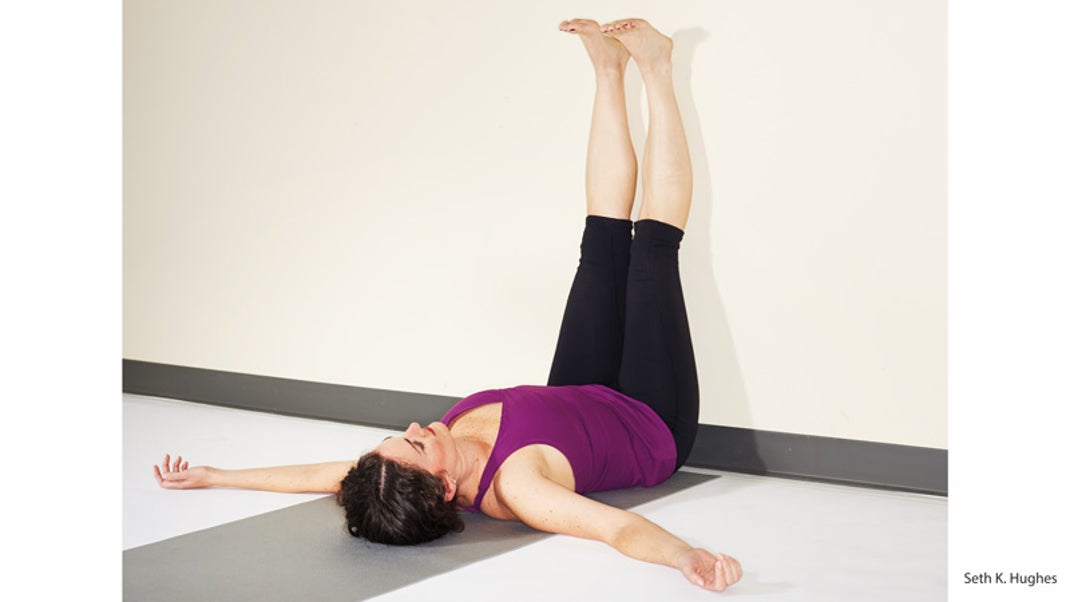I’ve been traveling a lot for work lately, trips that involve a lot of sitting–in cars, at tables, on airplanes–and not a lot of movement. Because of that, yoga has been hard to come by; five minutes of surreptitious airport psoas stretching does not a full practice make. On my days off, I need yoga badly.
When I came home earlier this month after a five-day trip, my sacrum was locked, my hips stiff, and my shoulders crackly. There was only one solution. I did yoga, greedily, like a dog licking a plate of leftovers. There were only a few days until my next trip, so I packed my classes in close.
When most people, even people who practice, hear the phrase “did yoga,” they imagine a sweaty vinyasa flow class that gets your heart pumping and pulls your IT band from stem to stern. That’s not what I undertook. Instead, I put myself on a course of yin yoga. This is a style, performed either seated, prone, or on your knees, where you hold poses for three to five minutes, often using props. It’s heavily influenced by traditional Chinese medicine, designed to stretch your connective tissue, massage your joints, put minimal heat on the muscles, and generally heal what ails you.
After a three-class program, one of which I spent mostly in an L shape with my legs up the wall, I felt better, not totally regenerated, but good enough to head back on the road. My body was ready to sit for five more days. Yoga had prepared me for the journey ahead.
When I first started practicing, nearly a decade ago, I used yoga as an exercise program. That may be because I started at a gym. Regardless, it worked. I lost weight and gained muscle. For the first time since I was a teenager, I had confidence in my body and walked with a broad stride.
Now, many years and many minor injuries later, yoga serves a different purpose for me. I don’t use it as an exercise program. Instead, I consider yoga preventative health care. It can lower blood pressure. Joints atrophy less slowly. After practicing, I move through the world more calmly, and with less stress. My body, now firmly established in middle age, may not be worthy of a magazine spread, but it works a lot better than it otherwise would.
Obviously, if you’re sick, see a doctor. Yoga doesn’t help much with pneumonia or bacterial infections. But if you’re just feeling a little off, a little grumpy, or a little stiff, well, I recommend you spend a few minutes in Sphinx Pose. It’s amazing how quickly your perspective can shift.
The need to balance the yin and the yang
In the Taoist tradition, the Yin-Yang symbol reflects the two opposing forces found in nature, as well as within ourselves. The yin is associated with night, earth, fragility and feminine energy while the yang is associated with day, heaven, strength and masculine energy. To achieve balance, harmony and peace one must embrace both opposing forces to maintain a healthy mind, body and spirit.
Symptoms of imbalance in the human body
Good health is often seen as a state where many aspects of the human body are in balance. Ideally, your energy levels should be high enough to keep you awake and active during the day and good sleep at night; your appetite should be well regulated; and your mental capacity can range from feeling elated to gloomy. This article will explore how health issues like insomnia, mood swings, and even physical pain may be caused by imbalances in certain systems of the body.
What causes yin and yang imbalances in the body
The world of Traditional Chinese Medicine is based on the understanding that everything in nature has yin and yang. The yin may be described as the shady side of a mountain, or winter, or water. The yang may be described as the sunny side of a mountain, summer, or fire. When one element reaches its extreme it needs to balance with the other element. This balance is known as “yin-yang equilibrium.
How to maintain harmony between yin and yang
It can be difficult to maintain harmony between yin and yang, but there are many ways we can help. One is by sleeping with a small urn or container of water on the left side of the bed as this will absorb some of the “yin” energy throughout the night. We can also make sure to keep our home, workplace, and car tidy as this will help us feel more grounded. Finally, we can meditate before bed with an intention for balance.
Conclusion:
Morning sickness can affect pregnant women in varying degrees. Symptoms of the condition may include, but are not limited to nausea, vomiting, and a lack of appetite. There are a few different coping methods that pregnant women can employ in order to combat the symptoms of morning sickness. One of them is herbal remedies for morning sickness, such as ginger root. Ginger has been used medicinally for centuries to treat various stomach ailments.




